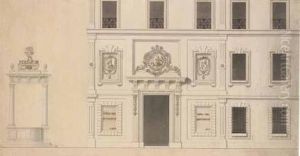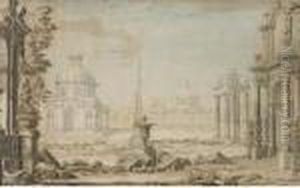Giovanni Carlo Bibiena Paintings
Giovanni Carlo Maria Claudio Michele Angelo Bibiena was an Italian architect, designer, and painter, born in 1676 in Parma, Italy, into the renowned Bibiena family, a dynasty of artists and architects that played a significant role in the development of Baroque theater design, decoration, and architecture in Italy and beyond. His father, Ferdinando Galli Bibiena, and his family were prominent figures in the world of Baroque art, and Giovanni Carlo was to carry on this rich artistic legacy, contributing significantly to the art and architecture of the 18th century.
Giovanni Carlo Bibiena received his initial training from his father, absorbing the principles of theatrical design, architecture, and painting at a young age. He was especially adept in the design of intricate stage settings and the creation of illusionistic architectural perspectives, a hallmark of the Bibiena family's style. This talent made him a sought-after designer for theater and opera productions across Europe. His work was characterized by elaborate decorations and an innovative use of space, which contributed to the evolution of scenography, particularly in the realm of opera.
Throughout his career, Bibiena worked for several important courts in Europe, including those in Vienna, where he served as the court architect and theater designer for the Habsburgs, and in Berlin, at the court of Frederick I of Prussia. His designs for court festivities, operas, and theaters were celebrated for their inventiveness and grandeur, blending architectural elements with dramatic theatrical effects. One of his most notable contributions was to the development of the 'Italian scenic perspective,' a technique that employed angled wings and backdrop paintings to create the illusion of depth on the stage, a practice that greatly influenced the future of stage design.
Beyond his theatrical work, Giovanni Carlo Bibiena also made contributions to architectural design, though fewer of his architectural works have survived. He was involved in designing palaces and churches, where he applied the same principles of grandeur and illusionistic depth that characterized his stage designs. His work not only exemplified the Baroque style but also contributed to its evolution, integrating elements of the emerging Rococo style, with its emphasis on lighter decoration and more fluid forms.
Giovanni Carlo Bibiena died in 1747, leaving behind a legacy that had a lasting impact on the fields of theater design, scenography, and Baroque architecture. His work continued to influence generations of artists and architects, and the Bibiena family name remained synonymous with artistic innovation and excellence in the European art world for many years.

